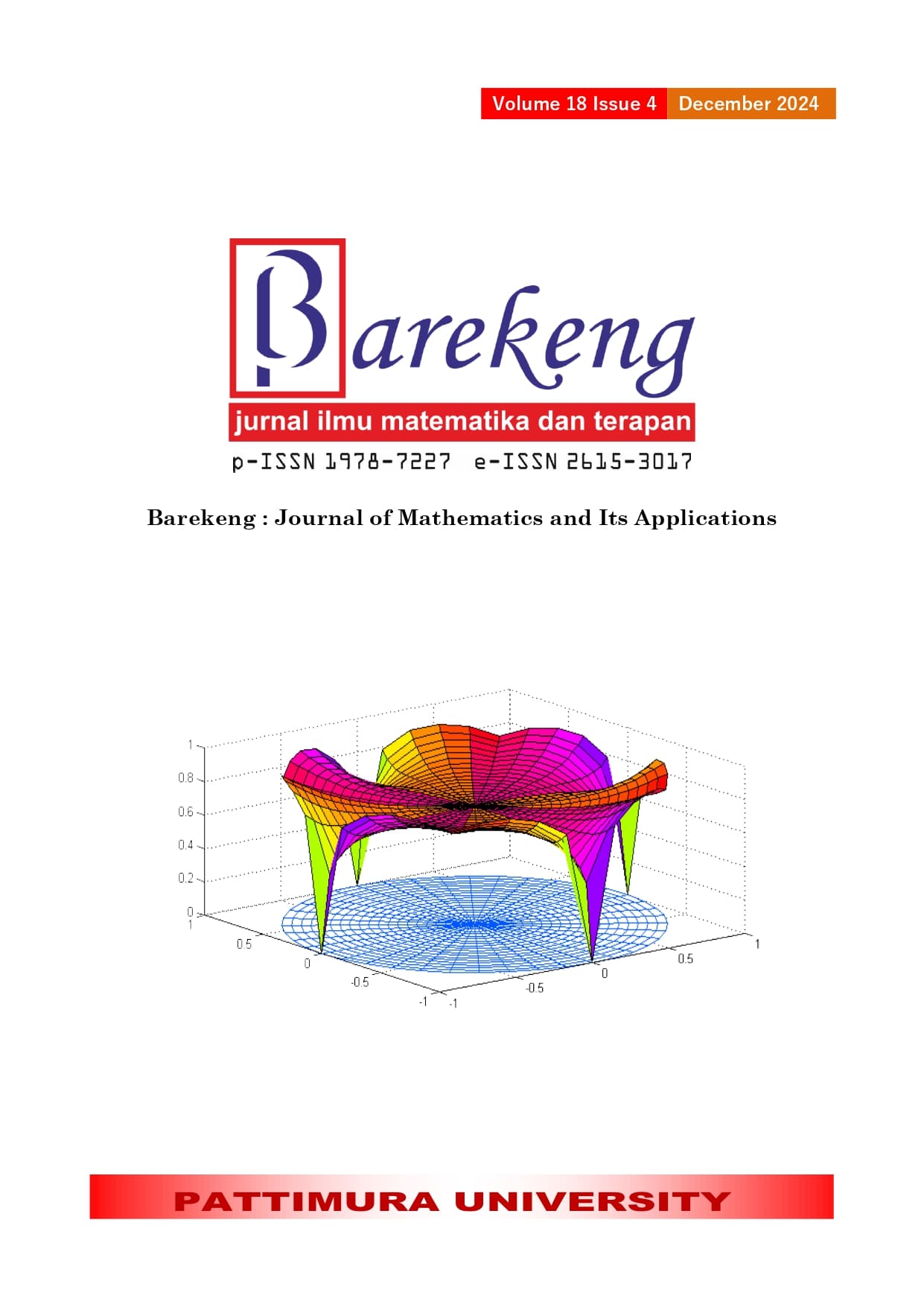DYNAMICAL BEHAVIOR IN THE COMPETITIVE MODEL INCORPORATING THE FEAR EFFECT OF PREY DUE TO ALLELOPATHY WITH SHARED BIOTIC RESOURCES
Abstract
This research develops a mathematical model of a natural phenomenon, namely sea snails that can release toxins (allelopathy) so that non-toxic sea snails become afraid. In addition, toxic and non-toxic sea snails share biotic resources. Based on the existing phenomenon, the model of fear effect caused by allelopathy in the competitive interaction model with shared biotic resources will be studied. In this system, three equilibrium points are obtained: extinction point of prey, extinction point of predator, and coexisting point under certain conditions. Analysis of local stability at equilibrium points by linearization shows that all equilibrium points are asymptotically stable with certain conditions. Numerical simulations at the equilibrium point show the same results as the analysis results. Then, numerical continuity was carried out by selecting variation of the fear effect parameter for Numerical continuity results show that changes in these parameters affect the population of toxic and non-toxic species, marked by the emergence of Transcritical bifurcations, Bifurcation occurs at the first Saddle-Node bifurcation at and the second Saddle-Node bifurcation at
Downloads
References
R. Effendi, H. Salsabila, and A. Malik, “Pemahaman Tentang Lingkungan Berkelanjutan,” Modul, vol. 18, no. 2, p. 75, 2018, doi: 10.14710/mdl.18.2.2018.75-82.
N. H. T. Siahaan, Hukum lingkungan dan ekologi pembangunan. Erlangga, 2004.
W. Magdalena, A. A. Kushadiwijayanto, and Y. P. Putra, “Struktur Komunitas Siput Laut (Kelas: Gastropoda) di Pesisir Dusun Karang Utara, Pulau Lemukutan,” J. Laut Khatulistiwa, vol. 2, no. 2, pp. 72–78, 2019.
S. J. Rizvi, Allelopathy: basic and applied aspects. Springer Science & Business Media, 2012.
P. V Andrade-Villagrán, M. J. Agüero, J. M. Navarro, and Á. Urzúa, “The paralytic shellfish toxin effect on bioenergetic constituents of the fishery resource Chorus giganteus,” Mar. Environ. Res., vol. 180, p. 105735, 2022.
H. M. Safuan and S. B. Musa, “Food chain model with competition interaction in an environment of a biotic resource,” in AIP Conference Proceedings, AIP Publishing, 2016.
F. Chen, X. Gong, and W. Chen, “Extinction in two dimensional discrete Lotka-Volterra competitive system with the effect of toxic substances (II),” Dyn. Contin. Discret. Impuls. Syst., Appl. Algorithms, vol. 20, no. 4, pp. 449–461, 2013.
S. Chen, F. Chen, V. Srivastava, and R. D. Parshad, “Dynamical Analysis of an Allelopathic Phytoplankton Model with Fear Effect,” Sep. 2023, [Online]. Available: http://arxiv.org/abs/2309.08383
S. K. Sasmal and Y. Takeuchi, “Dynamics of a predator-prey system with fear and group defense,” J. Math. Anal. Appl., vol. 481, no. 1, p. 123471, 2020.
X. Wang, L. Zanette, and X. Zou, “Modelling the fear effect in predator–prey interactions,” J. Math. Biol., vol. 73, no. 5, pp. 1179–1204, 2016.
K. Kundu, S. Pal, S. Samanta, A. Sen, and N. Pal, “Impact of fear effect in a discrete-time predator-prey system,” Bull. Calcutta Math. Soc, vol. 110, pp. 245–264, 2018.
D. Savitri and M. Jakfar, “The Dynamics of Modified Leslie-Gower the Pest-Predator System with Additional Food and Fear Effect,” in International Joint Conference on Science and Engineering (IJCSE), Atlantis Press, pp. 519–525, 2021.
V. Srivastava, E. M. Takyi, and R. D. Parshad, “The effect of" fear" on two species competition,” arXiv Prepr. arXiv2210.10280, 2022.
J. D. Wiens, R. G. Anthony, and E. D. Forsman, “Competitive interactions and resource partitioning between northern spotted owls and barred owls in western Oregon,” Wildl. Monogr., vol. 185, no. 1, pp. 1–50, 2014.
S.-Y. Wang, W.-M. Chen, and X.-L. Wu, “Competition analysis on industry populations based on a three-dimensional lotka–volterra model,” Discret. Dyn. Nat. Soc., vol. 2021, 2021.
P. B. Adler et al., “Competition and coexistence in plant communities: intraspecific competition is stronger than interspecific competition,” Ecol. Lett., vol. 21, no. 9, pp. 1319–1329, 2018.
P. Panday, N. Pal, S. Samanta, and J. Chattopadhyay, “Stability and bifurcation analysis of a three-species food chain model with fear,” Int. J. Bifurc. Chaos, vol. 28, no. 01, p. 1850009, 2018.
S. N. Abdullah, H. M. Safuan, M. E. Nor, S. S. Jamaian, F. Aman, and N. F. M. Shab, “Harvesting effects on population model of competitive interaction with shared biotic resource,” in AIP Conference Proceedings, AIP Publishing, 2018.
S. L. Campbell and R. Haberman, Introduction to differential equations with dynamical systems. Princeton university press, 2011.
M. Chávez-Pichardo, M. A. Martínez-Cruz, A. Trejo-Martínez, D. Martínez-Carbajal, and T. Arenas-Resendiz, “A complete review of the general quartic equation with real coefficients and multiple roots,” Mathematics, vol. 10, no. 14, p. 2377, 2022.
W. E. Boyce, R. C. DiPrima, and D. B. Meade, Elementary differential equations. John Wiley & Sons, 2017.
R. J. Iswanto, “Pemodelan matematika aplikasi dan terapannya,” Yogyakarta Graha Ilmu, vol. 201, no. 1, 2012.
Copyright (c) 2024 Mifta Kharisma Dewi, Dian Savitri, Abadi Abadi

This work is licensed under a Creative Commons Attribution-ShareAlike 4.0 International License.
Authors who publish with this Journal agree to the following terms:
- Author retain copyright and grant the journal right of first publication with the work simultaneously licensed under a creative commons attribution license that allow others to share the work within an acknowledgement of the work’s authorship and initial publication of this journal.
- Authors are able to enter into separate, additional contractual arrangement for the non-exclusive distribution of the journal’s published version of the work (e.g. acknowledgement of its initial publication in this journal).
- Authors are permitted and encouraged to post their work online (e.g. in institutional repositories or on their websites) prior to and during the submission process, as it can lead to productive exchanges, as well as earlier and greater citation of published works.






1.gif)



